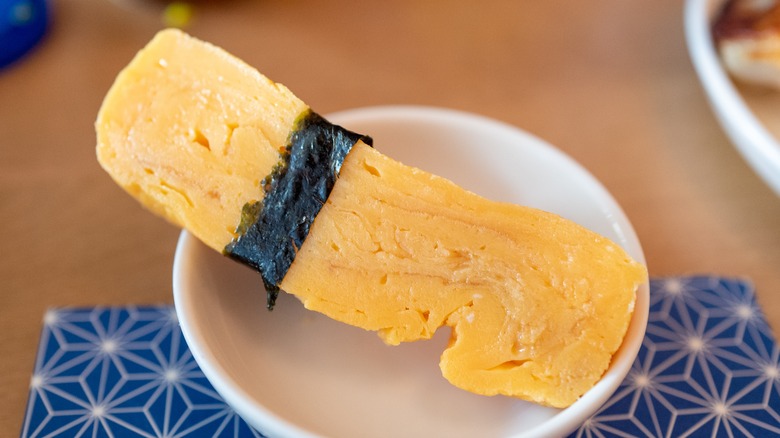Save Room Alongside The Fish For Tamago At Your Next Sushi Dinner
When you think of sushi, you may imagine thick slices of raw fish atop little rice patties. And while this is often the case, not all sushi is raw (see unagi, aka cooked eel, for example) — and not all of it is fish. You may never have ordered tamago off a menu, especially if you're going to a restaurant with fish on the brain. But the next time you're out to dinner, don't skip over this version of sushi — aka, these little Japanese omelets served over rice.
If it doesn't sound like omelets would go well with other fishy dishes, tamago isn't the same as the versions we would typically order for breakfast in the U.S. The dish is named after the Japanese word for "egg," but it's dressed up with rice vinegar, soy sauce, sugar, sake, mirin, or dashi, so the flavors complement those in sushi well. Not only does tamago have multiple flavors (sweet, salty, tart), but it also has layers of texture. The eggs are fried and rolled together in thin layers before being plopped on top of a rice rectangle and wrapped in a thin seaweed ribbon. It may not generally be the star of the show at sushi restaurants, but it's an option you won't want to miss.
Low and high-end versions of tamago
When you do spot tamago, it's typically a testament to the quality of the sushi restaurant. Traditionally, making eggs in this style was a way to test the training and experience of the sushi chef, and diners would often order it before the meal to assess the chef's skill level. Today, you may just find tamago in the form of egg slices piled on top of each other. However, nicer sushi restaurants may offer an even fancier version made with ground seafood and extra sugar.
The type of tamago we've mentioned (that comes with rice and is wrapped in seaweed) is called nigiri — but it's not the only way you can order this dish. Minus the latter two ingredients, you've got tamagoyaki, which is just the rolled egg omelet. When it's not served at sushi restaurants, it's typically eaten for breakfast in Japan and made in a special square-shaped pan. You may also see it in breakfast versions of ramen or other soups, served as a side dish for lunch or in bento boxes for kids. It's still delicious in these forms, but this omelet shines best when you order it with your sushi dinner.

